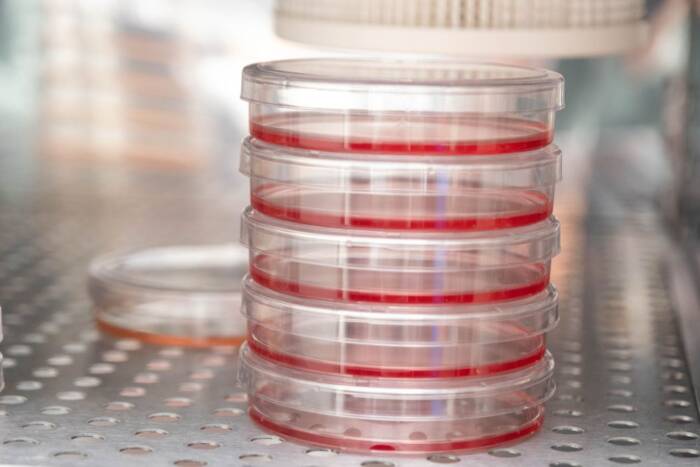Structural study shows how bacteria select their most virulent proteins
Salmonella poisoning, dysentery, the plague, typhoid fever, and a number of other serious ailments are caused by a diverse group of bacterial pathogens that have one thing in common: They all use the same syringe-like system to infect their hosts. Known as a “type III secretion system,” this trait allows bacteria to inject virulent proteins straight into the cells of the organism they’re infecting. Now, Rockefeller researchers have uncovered the first structural similarity shared by these disparate but virulent proteins, a similarity that may help direct future antibiotic research.
 (opens in new window)
(opens in new window)
Attack of the proteins. The InvB molecule in Salmonella bacteria acts to chaperone four different virulent proteins out of the bacteria and into a host cell. Here, a ribbon diagram shows InvB (blue and yellow) as it binds (purple arrow) to one of these virulent invasion proteins, SipA (red).
The type III secretion system was discovered more than fifteen years ago. But the pathogens that use it are so varied that no one had been able to discern what their destructive proteins — called virulence factors — had in common to help them bind to the small chaperone molecules that allow bacteria to secrete them. In a paper published in Molecular Cell, C. Erec Stebbins, assistant professor and head of Rockefeller’s Laboratory of Structural Microbiology, identifies a common mechanism by which these virulence factors interact with their chaperones, creating a potential target for future anti-bacterial drugs.
Stebbins and his coauthors — research associate Mirjana Lilic and postdoctoral associate Milos Vujanac, both in Stebbins’ lab — started by determining the structure of a particularly important chaperone molecule, InvB, which binds to four different virulence factors in the Salmonella bacteria. Then, to understand how it could interact with four different proteins, the group turned its attention to the virulence factors. By examining their genetic sequences, the researchers found a similarity that extended beyond those four Salmonella proteins to the virulence factors of a large number of animal (and some plant) pathogens. So Stebbins used these sequences to examine their structures and compare them to each other. And when he lined them up, he found that they all overlapped in one small region — a short length of each protein went through the same three-dimensional space. “So far, this is the only common element found in all the virulence factors characterized to date,” Stebbins says.
The region Stebbins discovered is a beta sheet, a part of the protein folded so as to create a stable, corrugated layer. And jutting out from each virulence factor’s beta sheet were specific amino acids, different residues that shared one common feature: They all repelled water. Then Stebbins looked for a corresponding structure on InvB that would allow the beta sheet to bind. He found it, and also found similar binding domains in nearly every chaperone molecule he looked at. “This is the first time something similar in the interactions between these substrates and their chaperones has been identified,” he says. “Something unifying, which is exciting because we’ve been trying very hard to find some sort of unifying characteristic.”
To determine whether this characteristic is what allows for chaperone-virulence factor recognition, Stebbins mutated the Salmonella invasion proteins. Almost every beta-sheet modification prevented the proteins from binding to their chaperones, as well as preventing them from being secreted by the bacterium. Modifications to invasion proteins from a different bacterial pathogen, the plague-causing Yersinia, also prevented protein-chaperone binding. Stebbins’ “beta motif,” it seems, is vital to bacterial virulence.
This shared feature presents a potential drug target. Rather than working to create specialized therapies for individual bacteria species, Stebbins says, it may provide a way to disable many bacteria that use a type III secretion system, by preventing them from releasing their harmful proteins.
Molecular Cell 21: 653-664 (March 3, 2006)(opens in new window)


